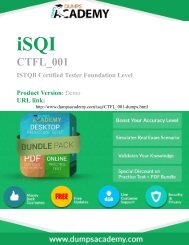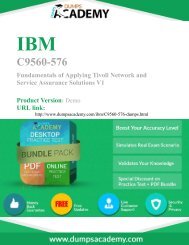CPA-Regulation Exam For Best Results in Actual Exam
You also want an ePaper? Increase the reach of your titles
YUMPU automatically turns print PDFs into web optimized ePapers that Google loves.
AI<strong>CPA</strong><br />
<strong>CPA</strong>-REGULATION<br />
<strong>CPA</strong> <strong>Regulation</strong><br />
Product Version: Demo<br />
URL l<strong>in</strong>k:<br />
http://www.dumpsacademy.com/aicpa/<strong>CPA</strong>-REGULATION-dumps.html
Question 1<br />
Parker, whose spouse died dur<strong>in</strong>g the preced<strong>in</strong>g year, has not remarried. Parker ma<strong>in</strong>ta<strong>in</strong>s a home for a<br />
dependent child. What is Parker's most advantageous fl<strong>in</strong>g status?<br />
A. S<strong>in</strong>gle.<br />
B. Head of household.<br />
C. Married fl<strong>in</strong>g separately.<br />
D. Qualify<strong>in</strong>g widow(er) with dependent child.<br />
Aoswern D<br />
Explanaton<br />
Choice "d" is correct. A qualify<strong>in</strong>g widow (er) is a taxpayer who may use the jo<strong>in</strong>t tax return standard<br />
deducton and rates (but not the exempton for the deceased spouse) for each of two taxable years<br />
follow<strong>in</strong>g the year of death of his or her spouse, unless he or she remarries. The surviv<strong>in</strong>g spouse must<br />
ma<strong>in</strong>ta<strong>in</strong> a household that, for the whole entre taxable year, was the pr<strong>in</strong>cipal place of abode of a son,<br />
stepson, daughter, or stepdaughter (whether by blood or adopton). The surviv<strong>in</strong>g spouse must also be<br />
enttled to a dependency exempton for such <strong>in</strong>dividual. Parker may fle as a qualify<strong>in</strong>g widow (er) s<strong>in</strong>ce<br />
her spouse died <strong>in</strong> the previous tax year, she did not remarry and she ma<strong>in</strong>ta<strong>in</strong>ed a home for a<br />
dependent child. S<strong>in</strong>ce, qualify<strong>in</strong>g widow (er) is the most advantageous status and Parker qualifes,<br />
Parker would fle as a qualify<strong>in</strong>g widow (er).<br />
Choice "a" is <strong>in</strong>correct. Even though Parker would qualify as s<strong>in</strong>gle, fl<strong>in</strong>g s<strong>in</strong>gle would give Parker a high<br />
tax liability than the qualify<strong>in</strong>g widow (er) status and therefore is not most advantageous.<br />
Choice "b" is <strong>in</strong>correct. Parker would not qualify as head of household for the frst two years afer the<br />
death of Parker's spouse because one of the requirements for Head of Household status is that the<br />
taxpayer is NOT a surviv<strong>in</strong>g spouse. (Also, note that the likely reason for this requirement is that fl<strong>in</strong>g as<br />
Head of Household status would give the qualify<strong>in</strong>g surviv<strong>in</strong>g spouse taxpayer a higher tax liability than<br />
the Qualify<strong>in</strong>g Widow(er) status, which would be less advantageous.)<br />
Choice "c" is <strong>in</strong>correct. Parker would not qualify to fle married fl<strong>in</strong>g separately.<br />
Question 2<br />
In which of the follow<strong>in</strong>g situatons may taxpayers fle as married fl<strong>in</strong>g jo<strong>in</strong>tly?<br />
A. Taxpayers who were married but lived apart dur<strong>in</strong>g the year.<br />
B. Taxpayers who were married but lived under a legal separaton agreement at the end of the year.<br />
C. Taxpayers who were divorced dur<strong>in</strong>g the year.<br />
D. Taxpayers who were legally separated but lived together for the entre year.<br />
Aoswern A<br />
Explanaton<br />
RULE: In order to fle a jo<strong>in</strong>t return, the partes must be MARRIED at the end of the year. Excepton: If the
partes are married but are LEGALLY SEPARATED under the laws of the state <strong>in</strong> which they reside, they<br />
cannot fle a jo<strong>in</strong>t return (they will fle either under the s<strong>in</strong>gle or head of household fl<strong>in</strong>g status).<br />
Choice "a" is correct. Per the above rule, taxpayers who are married but lived apart dur<strong>in</strong>g the year are<br />
allowed to fle a jo<strong>in</strong>t return for the year. The fact that they did not live together dur<strong>in</strong>g the year has no<br />
bear<strong>in</strong>g on the issue.<br />
Choice "b" is <strong>in</strong>correct. Per the above rule, taxpayers who are married but lived under a legal separaton<br />
agreement at the end of the year may not fle a jo<strong>in</strong>t return. They will generally fle either under the<br />
s<strong>in</strong>gle or head of household fl<strong>in</strong>g status.<br />
Choice "c" is <strong>in</strong>correct. Per the above rule, taxpayers who were divorced dur<strong>in</strong>g the year may not fle a<br />
jo<strong>in</strong>t return together, as they are not married at the end of the year. [Note, however, that they may<br />
become married aga<strong>in</strong> <strong>in</strong> the year and fle a jo<strong>in</strong>t return with the new spouse.]<br />
Choice "d" is <strong>in</strong>correct. Per the above rule, taxpayers who were legally separated but lived together for<br />
the entre year may not fle a jo<strong>in</strong>t return. They will generally fle either under the s<strong>in</strong>gle or head of<br />
household fl<strong>in</strong>g status.<br />
Question 3<br />
Barkley owns a vacaton cab<strong>in</strong> that was rented to unrelated partes for 10 days dur<strong>in</strong>g the year for<br />
$2,500. The cab<strong>in</strong> was used personally by Barkley for three months and lef vacant for the rest of the<br />
year. Expenses for the cab<strong>in</strong> were as follows:<br />
Real estate taxes $1,000<br />
Ma<strong>in</strong>tenance and utlites $2,000<br />
How much rental <strong>in</strong>come (loss) is <strong>in</strong>cluded <strong>in</strong> Barkley's adjusted gross <strong>in</strong>come?<br />
A. $0<br />
B. $500<br />
C. $(500)<br />
D. $(1,500)<br />
Aoswern A<br />
Explanaton<br />
RULE: If a vacaton residence is rented for less than 15 days per year, it is treated as a personal residence.<br />
The rental <strong>in</strong>come is excluded from <strong>in</strong>come, and mortgage <strong>in</strong>terest (frst or second home) and real estate<br />
taxes are allowed as itemized deductons. Depreciaton, utlites, and repairs are not deductble.<br />
Choice "a" is correct. Apply<strong>in</strong>g the rule above, if a vacaton residence is rented for less than 15 days per<br />
year, it is treated as a personal residence. The rental <strong>in</strong>come ($2,500 <strong>in</strong> this case) is excluded from<br />
<strong>in</strong>come. A Schedule E is not fled for this property (i.e., no <strong>in</strong>come is reported, the taxes are reported as<br />
itemized deductons, and the ma<strong>in</strong>tenance and utlites are not deductble), so the efect on AGI is zero.<br />
Choice "b" is <strong>in</strong>correct. This assumes that the property taxes are reported as itemized deductons but<br />
that the rental <strong>in</strong>come ($2,500) less the ma<strong>in</strong>tenance and utlites ($2,000) are reported net on Schedule<br />
E.<br />
Per the above RULE, the rental <strong>in</strong>come is excluded from <strong>in</strong>come, and the ma<strong>in</strong>tenance and utlites are<br />
not deductble.<br />
Choice "c" is <strong>in</strong>correct. This assumes that all of the items shown are reported net on the Schedule E-<br />
$2,500 - $1,000 - $2,000 = ($500). Per the above RULE, the rental <strong>in</strong>come is excluded from <strong>in</strong>come, the<br />
ma<strong>in</strong>tenance and utlites are not deductble, and the property taxes are reported on Schedule A as an
itemized deducton.<br />
Choice "d" is <strong>in</strong>correct, per the above rule and discussion.<br />
Question 4<br />
In evaluatng the hierarchy of authority <strong>in</strong> tax law, which of the follow<strong>in</strong>g carries the greatest<br />
authoritatve value for tax plann<strong>in</strong>g of transactons?<br />
A. Internal Revenue Code.<br />
B. IRS regulatons.<br />
C. Tax court decisions.<br />
D. IRS agents' reports.<br />
Aoswern A<br />
Explanaton<br />
Note: This queston is addressed <strong>in</strong> your Appendix D text materials. We are confdent that our students<br />
would be able to respond correctly over 85% of the tme without any guidance on this topic. The answer<br />
is rather obvious. Just by look<strong>in</strong>g at the answer optons, you will immediately notce that Opton A is<br />
presented <strong>in</strong> ttle case. This would be a quick sign that it may be the correct response. Further, we<br />
suspect that most students would narrow the optons down to "a" or "b" by simply us<strong>in</strong>g common sense.<br />
While we are confdent that our students would fare well on this queston if it appeared on their exams,<br />
we present the follow<strong>in</strong>g detailed explanaton of the answer optons.<br />
Choice "a" is correct. Accord<strong>in</strong>g to the IRS's website under Tax Code, Regulatons and Ofcial Guidance,<br />
the "federal tax law beg<strong>in</strong>s with the Internal Revenue Code (IRC), [which was] enacted by Congress <strong>in</strong><br />
Title 26 of the United States Code (26 U.S.C.)." The IRC holds the most authoritatve value.<br />
Choice "b" is <strong>in</strong>correct. Accord<strong>in</strong>g to the IRS's website under Tax Code, Regulatons and Ofcial Guidance,<br />
the IRS regulatons or "Treasury regulatons (26 C.F.R.)-commonly referred to as Federal tax regulatonspick<br />
up where the Internal Revenue Code (IRC) leaves of by provid<strong>in</strong>g the ofcial <strong>in</strong>terpretaton of the<br />
IRS by the U.S. Department of Treasury." Regulatons give directons on how to apply the law outl<strong>in</strong>ed <strong>in</strong><br />
the Internal Revenue Code. Regulatons have the second most force and efect, second only to the IRC.<br />
Choice "c" is <strong>in</strong>correct. Tax court decisions <strong>in</strong>terpret the Internal Revenue Code. They do not have the<br />
authority of the IRC.<br />
Choice "d" is <strong>in</strong>correct. The reports of IRS agents are used to report on specifc taxpayer situatons. IRS<br />
agents' reports apply the Internal Revenue Code, IRS regulatons, and other forms of authoritatve<br />
literature, but they do not hold the value that the IRC, the IRS regulatons, or even tax court decisions<br />
have.<br />
Individual Taxaton - Exemptons<br />
Question 5<br />
In 19X4, Smith, a divorced person, provided over one half the support for his widowed mother, Ruth, and<br />
his son, Clay, both of whom are U.S. citzens. Dur<strong>in</strong>g 19X4, Ruth did not live with Smith. She received<br />
$9,000 <strong>in</strong> Social Security benefts. Clay, a 25 year-old full-tme graduate student, and his wife lived with<br />
Smith. Clay had no <strong>in</strong>come but fled a jo<strong>in</strong>t return for 19X4, ow<strong>in</strong>g an additonal $500 <strong>in</strong> taxes on his<br />
wife's <strong>in</strong>come. How many exemptons was Smith enttled to claim on his 19X4 tax return?
A. 4<br />
B. 3<br />
C. 2<br />
D. 1<br />
Aoswern C<br />
Explanaton<br />
Choice "c" is correct. Smith is enttled to an exempton for himself. He is also enttled to an exempton for<br />
his mother Ruth (qualify<strong>in</strong>g relatve). Ruth has $9,000 <strong>in</strong> Social Security payments dur<strong>in</strong>g 19X4, but s<strong>in</strong>ce<br />
that is her only <strong>in</strong>come, the Social Security is not taxable, and nontaxable <strong>in</strong>come does not count <strong>in</strong><br />
calculatng whether an exempton can be taken for a dependent. Clay cannot be taken as a dependent<br />
because he fled a jo<strong>in</strong>t return with his wife. S<strong>in</strong>ce the jo<strong>in</strong>t return was fled for a purpose other than<br />
simply claim<strong>in</strong>g a refund, the jo<strong>in</strong>t return prevents Smith from claim<strong>in</strong>g an exempton for Clay. An<br />
exempton cannot be taken for Clay's wife because she fled a jo<strong>in</strong>t return with Clay. Smith is enttled to<br />
two exemptons.<br />
Choice "a" is <strong>in</strong>correct. Clay cannot be taken as a dependent because he fled a jo<strong>in</strong>t return with his wife.<br />
S<strong>in</strong>ce the jo<strong>in</strong>t return was fled for a purpose other than simply claim<strong>in</strong>g a refund, the jo<strong>in</strong>t return<br />
prevents Smith from claim<strong>in</strong>g an exempton for Clay. An exempton cannot be taken for Clay's wife<br />
because she fled a jo<strong>in</strong>t return with Clay.<br />
Choice "b" is <strong>in</strong>correct. Clay cannot be taken as a dependent because he fled a jo<strong>in</strong>t return with his wife.<br />
S<strong>in</strong>ce the jo<strong>in</strong>t return was fled for a purpose other than simply claim<strong>in</strong>g a refund, the jo<strong>in</strong>t return<br />
prevents Smith from claim<strong>in</strong>g an exempton for Clay. An exempton cannot be taken for Clay's wife<br />
because she fled a jo<strong>in</strong>t return with Clay.<br />
Choice "d" is <strong>in</strong>correct. Smith is enttled to an exempton for his mother, Ruth. Ruth has $9,000 <strong>in</strong> Social<br />
Security payments dur<strong>in</strong>g 19X4, but because that is her only <strong>in</strong>come, the Social Security <strong>in</strong>come is not<br />
taxable, and nontaxable <strong>in</strong>come does not count <strong>in</strong> calculatng whether an exempton can be taken for a<br />
dependent.<br />
Individual Taxaton - Gross Income<br />
Question 6<br />
Darr, an employee of Sorce C corporaton, is not a shareholder. Which of the follow<strong>in</strong>g would be <strong>in</strong>cluded<br />
<strong>in</strong> a taxpayer's gross <strong>in</strong>come?<br />
A. Employer-provided medical <strong>in</strong>surance coverage under a health plan.<br />
B. A $10,000 gif from the taxpayer's grandparents.<br />
C. The fair market value of land that the taxpayer <strong>in</strong>herited from an uncle.<br />
D. The dividend <strong>in</strong>come on shares of stock that the taxpayer received for services rendered.<br />
Aoswern D<br />
Explanaton<br />
Choice "d" is correct. An <strong>in</strong>dividual receiv<strong>in</strong>g common stock for services rendered must recognize the fair<br />
market value as ord<strong>in</strong>ary <strong>in</strong>come. Any dividends received on that stock would also result <strong>in</strong> <strong>in</strong>come<br />
recogniton.<br />
Choice "a" is <strong>in</strong>correct. Employer-provided medical <strong>in</strong>surance is a tax-free fr<strong>in</strong>ge beneft.
Choices "b" and "c" are <strong>in</strong>correct. Gifs and <strong>in</strong>heritances are both tax-free to the recipient. (Remember<br />
tax is ofen paid by the person giv<strong>in</strong>g the gif or the estate at death.)<br />
Question 7<br />
Adams owns a second residence that is used for both personal and rental purposes. Dur<strong>in</strong>g 2001, Adams<br />
used the second residence for 50 days and rented the residence for 200 days. Which of the follow<strong>in</strong>g<br />
statements is correct?<br />
A. Depreciaton may not be deducted on the property under any circumstances.<br />
B. A rental loss may be deducted if rental-related expenses exceed rental <strong>in</strong>come.<br />
C. Utlites and ma<strong>in</strong>tenance on the property must be divided between personal and rental use.<br />
D. All mortgage <strong>in</strong>terest and taxes on the property will be deducted to determ<strong>in</strong>e the property's net<br />
<strong>in</strong>come or loss.<br />
Aoswern C<br />
Explanaton<br />
Choice "c" is correct. Because the second property was personally used more than 14 days, any net loss<br />
from the rental of the property will be disallowed.<br />
All related expenses must be prorated between the personal use porton and the rental actvity porton.<br />
Prorated depreciaton is permited for the rental actvity.
THANKS FOR TRYING THE DEMO OF OUR PRODUCT<br />
Visit Our Site to Purchase the Full Set of <strong>Actual</strong> <strong>CPA</strong>-REGULATION <strong>Exam</strong><br />
Questons With Answers.<br />
htp:::www.dumpsacademy.com:aicpa:<strong>CPA</strong>-REGULATIONdumps.html<br />
We Also Provide Practce <strong>Exam</strong> Sofware That Simulates Real <strong>Exam</strong><br />
Environment And Has Many Self-Assessment Features. Download Free<br />
Product Demo From:<br />
htp:::www.dumpsacademy.com:aicpa:<strong>CPA</strong>-REGULATIONdumps.html<br />
Money Back Guarantee
















